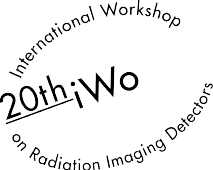Speaker
Description
The MÖNCH [1] detector is a low-noise charge-integrating hybrid pixel detector with 25 μm pixel pitch currently being developed at the Paul Scherrer Institut (PSI) optimized to be used in soft X-ray applications at synchrotrons and X-ray free electron lasers (XFELs). Suitable instruments for experiments in the soft X-ray energy range (250–2000 eV) present several technological challenges. Detectors should provide high Detective Quantum Efficiency (DQE), high Signal-to-Noise Ratio (SNR), high resolution, large dynamic range and need to handle frame rates higher than 1kHz. Additionally, they need to be operational under high vacuum conditions.
MÖNCH 03 [2], a prototype readout chip of the detector, meets most of the requirements to be used in soft X-ray experiments due to its remarkable low noise performance of 36 e- ENC and single photon resolution. But some optimizations are still needed such as reducing the thickness of the sensor backside implant for an improved quantum efficiency below 4 keV. Therefore, the aim of this work is to optimize the DQE of the MÖNCH detector with a thin entrance window to increase the detection efficiency in the soft X-ray regime.
Four silicon sensors with different entrance windows were produced at FBK and bump-bonded to the MÖNCH readout chip. The four prototypes of 160x160 pixels with 25 μm pitch (4 x 4 mm$^{2}$ of active area) were investigated using X-ray photons with energies between 400-2000 eV at the SIM beamline of the Swiss Light Source at PSI. The quantum efficiency of the four sensors has been compared and the thickness of the entrance window has been estimated. Additionally, the noise of the detection system has been measured as a function of the integration time and of the applied bias voltage. In this contribution, the first results of the DQE measured with the four sensors will be presented and discussed.
[1] R. Dinapoli et al, J. Instrum. 9 (2014) p. C050115.
[2] M. Ramilli et al, J. Instrum. 12 (2017) p. C01071.




